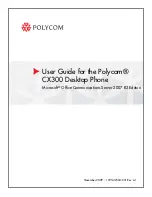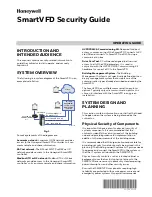
5.5.4.2 DSP Resource Advisor
Description
Web Maintenance Console provides a tool for calculating the number of resources required for a given set of
operating conditions. The Web Maintenance Console user provides information such as the number of ports
for a given resource (e.g., 16 extension ports using the G.729 codec) and the expected usage load (e.g., 50%
busy), and the resource advisor calculates the number of DSP resources required to meet those conditions.
This tool can be used in offline mode to simulate various PBX configurations and usage cases to help determine
the size of DSP card required.
This tool will also recommend which and how many resources to reserve for various features (
®
Resource Reservation). The recommended settings can be applied immediately from the resource advisor
tool.
The resource usage can be calculated using the following types of services and features:
Service/Feature
DSP Resources per Unit
Trunk using G.729 codec
2.2
Trunk using G.711 codec
1
Non-IP trunk (ISDN trunk, analogue trunk, etc.)
1
Extension using G.729 codec
2.2
Extension using G.711 codec
1
IP-CS extension using G.729 codec
2.2
IP-CS extension using G.711 codec
1
Unified Messaging
1.3
Two-way Recording
2.3
2
0.5
*1
The DSP costs of the extensions/trunks involved in the operation are not included in the per-unit DSP resource count.
*2
Two-way Recording also requires a conference trunk. For an example of the required DSP resources, see 5.5.4 DSP Resource
Usage.
Example 1: Small Office
In a small office (e.g., 32 employees), the necessary number of trunks and extensions is likely to be relatively
small. In addition, the expected load on the system will also be small.
(For clarity, unused services are not included in the table.)
Service
Number of Ports
Load (Busy Ratio %)
DSP Cost
Trunk using G.729 codec
3
5%
0.3
Non-IP trunk
1
5%
0.05
Extension using G.729 codec
32
10%
7.0
Unified Messaging
4
—
5.2
OGM
2
—
4.0
Conference
4
—
2.0
Feature Guide
537
5.5.4 DSP Resource Usage
Summary of Contents for KX-NS300
Page 14: ...14 Feature Guide Table of Contents ...
Page 15: ...Section 1 For Your Safety Feature Guide 15 ...
Page 18: ...18 Feature Guide 1 1 1 For Your Safety ...
Page 19: ...Section 2 Call Handling Features Feature Guide 19 ...
Page 107: ...User Manual References 1 2 1 Basic Calling Feature Guide 107 2 5 4 Trunk Call Features ...
Page 193: ...User Manual References 1 4 2 Holding a Call Feature Guide 193 2 13 1 Call Hold ...
Page 324: ...324 Feature Guide 2 30 2 Outgoing Message OGM ...
Page 325: ...Section 3 Unified Messaging System Feature Guide 325 ...
Page 375: ...Section 4 Network Features Feature Guide 375 ...
Page 464: ...464 Feature Guide 4 3 6 Network ICD Group ...
Page 465: ...Section 5 System Configuration and Administration Features Feature Guide 465 ...
Page 560: ...560 Feature Guide 5 6 7 PING Confirmation ...
Page 561: ...Section 6 Appendix Feature Guide 561 ...
Page 578: ...578 Feature Guide 6 5 2 PFMPR Software File Version 004 2xxxx ...
Page 579: ...Feature Guide 579 Notes ...
















































